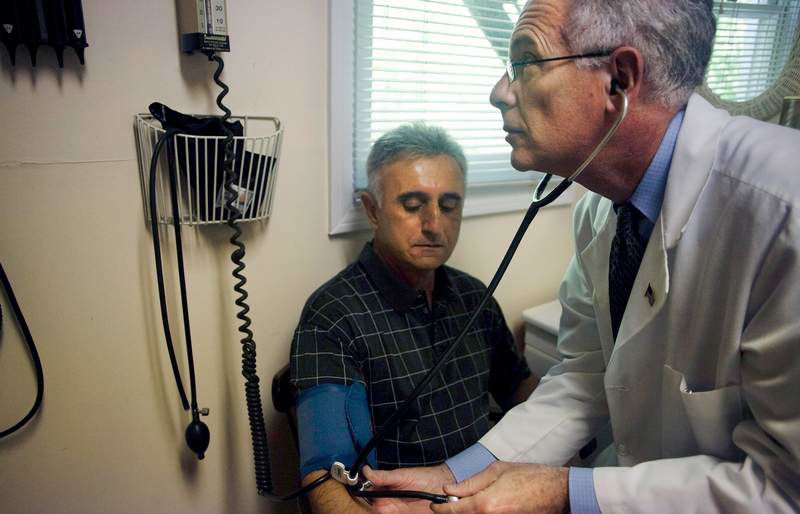Personal medicine so far shrugs off recession’s effects
Published 5:00 am Monday, May 11, 2009

- Fred Karam is examined last week by Dr. Robert Ruxin in Ridgefield, Conn. Karam, 66, remained a patient when Ruxin switched to a concierge practice in 2004. Concierge medical practices charge hefty membership fees for highly personalized care and around-the-clock access.
Thanks to patients who still value their health in hard times, the recession has barely slowed the growth of concierge medical practices, which charge hefty membership fees for highly personalized care and around-the-clock access.
From Seattle, where the movement began in 1996, to South Florida, where its largest concern is based, physicians with boutique practices say they are losing far fewer patients for financial reasons than they had expected. While some new practices are not filling as quickly as they might, they continue to attract a steady flow of patients willing to pay thousands of dollars for the privilege.
The practices typically charge at least $1,500 a year, with the most elite services asking $25,000 or more per family. The fees cover a thorough exam and enable physicians to limit the number of patients they see so they can provide premier service.
Doctors give patients their cell phone numbers and schedule leisurely same-day appointments with no waiting. Some make house calls, though patients still need health insurance to pay for hospitalizations and specialists.
Most of the 20 physicians and executives interviewed said that a small number of patients had decided not to re-enroll in recent months, citing lost jobs or devalued portfolios. They tend to be like Susan Schwartzman, a book publicist from Yonkers, N.Y., who said she had given up her concierge doctor because of declining income, but only after first canceling her gym membership and swearing off restaurants.
‘Cannot afford to be sick’
For the most part, however, boutique practices have shown resiliency. Doctors said the recession seemed to have reaffirmed the importance of health care to their patients. With jobs scarce and stress at a peak, many may see a link between continued health and continued employment. And with savings depleted, they recognize that assiduous preventive care may help them avoid costly chronic conditions and hospitalizations.
“It’s the old penny-wise, pound-foolish thing,” said Dr. C. Scott Molden, who practices internal medicine in St. Louis with MDVIP, the largest consortium of fee-based doctors. “I tell people, ‘You cannot afford to not be in my practice. You cannot afford to be sick, even with insurance.’ What I’m offering is to keep people out of hospitals.”
Ted McCallum, of Newtown, Conn., said that after losing his job as a hotel manager in June, he decided to stick with his MDVIP doctor, Robert Ruxin, of Ridgefield, because their 20-year relationship provided stability in unsettling times.
“It did involve forgoing some of the luxuries I’ve gotten used to,” McCallum, 57, said about losing his job. “But I wasn’t willing to forgo this one.
“As the saying goes, If you have your health, you’re a rich man,” he added.
Similarly, Janet Yerta, an 82-year-old retiree in Atlanta, has remained with her MDVIP physician, Dr. T. Kirkland Garner, despite watching her investment income wither. “I’m not one of those people that’s running over with money,” she said. “But there are two things I value: my salvation and my health.”
Critics of concierge medicine consider it elitist and say it has widened the already significant class disparities in American medicine. They also say it has exacerbated the shortage of primary care physicians by leaving more patients to be treated by a shrinking pool of doctors.
But advocates counter that the concierge movement reflects deep exasperation with the two-hour waits and 10-minute appointments of conventional primary care. Given the burnout among physicians who must see more than two dozen patients a day, they say the concierge model may sustain doctors who would otherwise hang up their stethoscopes.
Dr. Thomas LaGrelius, of Torrance, Calif., who leads the Society for Innovative Medical Practice Design, a professional association of concierge physicians, estimated that there were 5,000 such doctors in the United States, out of an estimated 240,000 internal medicine physicians and related subspecialists.
MDVIP, which started in Boca Raton, Fla., in 2000, expects to add more than 80 doctors to its network of 300 this year, said Darin Engelhardt, the firm’s president. The company is privately held and does not release detailed membership data, but Engelhardt said that the renewal rate among its 100,000 patients had remained at its usual level of 93 percent a year during the recession. Each MDVIP doctor is limited to 600 patients, who each pay $1,500 to $1,800 a year.
Still a priority
“I’m happily able to report that we have not seen any adverse impact from the economy,” Engelhardt said. “What we’ve been told by patients is that during difficult times like this, they are reassessing their priorities and that their health care needs come to the forefront.”
Dr. Dragan Djordjevic, a Chicago physician who affiliated with MDVIP two years ago, said he had expected a lot of dropouts. “Every day, patients would come in and talk about how the economy was killing them,” he said. “So naturally, I’d go home thinking they were going to cancel.”
But Djordjevic said that he had lost perhaps only five patients out of 600 since the beginning of the year, and that they had been easily replaced from a waiting list of more than 100.
Peter Hoedemaker, the chief executive of MD2, a concierge medical provider based near Seattle, said the company had been pleasantly surprised by patient enrollments at its new office in Chicago. The five MD2 practices, each with two doctors, charge $25,000 per family and limit each doctor to 50 patients. About a dozen openings remain in Chicago, Hoedemaker said, and the group is looking to expand to New York City.






